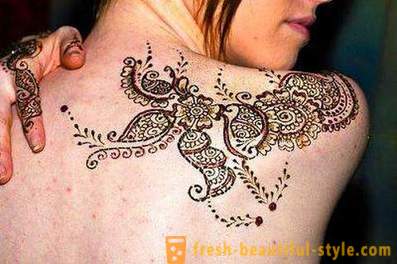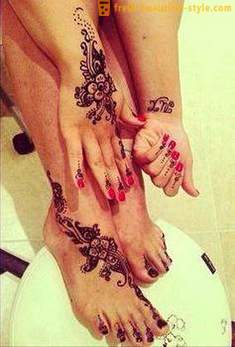Henna or mehndi art
In ancient Egypt and India, young beauties adorn their body with drawings and patterns that have a special meaning. Over time, the mysterious body art won the hearts of not only the oriental beauties, but also give the West European continent. And all because henna painting is an alternative to tattoos. This pattern looks nice and original. And the healing properties of henna add special attraction to this art.
The history of the mehendi

Henna - is an ancient tradition that originated about 5,000 years ago in India. Rituals create drawings are called "mehendi" ( "mehndi") on the body. The intricate images were carrying some sacred meaning. Mehendi originally used only for celebrations, particularly weddings. Figures henna decorated skin bride. Geometric patterns were applied to the hands, legs and forearms future wives. Image carried a religious meaning and emphasizes the beauty of oriental ladies. Tattoo in the form of a triangle embodied masculine activity, mean square stability and integrity, the star symbolizes divinity and hope. In India, mehendi was considered a symbol of a successful marriage for women. Oriental beauties still sincerely believe that the mysterious body art will give them lots of love and happiness in marriage. In addition, the mehendi to protect people from evil spirits, illnesses and fatalities.
The healing properties of henna
Mehendi has beneficial effects on the entire body. Henna has a cleaning effect on the subtle energy level. In the Vedic scholars said that human palms are chakras - the energy centers of the whole organism. They are located in the major nerve plexus, and regulate the operation of the different organs of the human body. Getting to the chakras, henna has a cleaning effect. In addition, it absorbs excess fat and maintain balance in the body. Mehendi - a kind of Vedic practices that are designed to awaken the "inner sun" in man. Therefore, the art has an important symbolic function.

How to prepare henna
The mixture for underwear painting made from natural henna leaves, which are ground on special grindstones. The henna powder is added aromatic oil, lemon juice and sugar. The resulting texture pattern is applied, which dries within half an hour. Initially, the paste is black. A few hours later henna peeled and changes hue from light orange to dark brown. henna painting lasts from 5 to 14 days depending on the skin type and the place of drawing.
Features of the application of henna
2 In the dye spread mehendi: indigo - blue color, and harkus - black. But the natural color of henna - only brown. The paste is applied to the individual areas of the body having different brightness intensity. On the neck of a picture looks less bright, and quickly washed off, but painted with henna on the hands and adopt a long-term saturated color. It is not recommended to apply permanent tattoo on the same area of the body to the skin can have a rest from external influences. Mehendi can be used no more than twice a month on a specific area of the body. Otherwise such entrainment can provoke skin disease of varying severity. Before applying henna tattoo from the skin should be degreased carefully washing out with soap and water. If part of the body by tattoos have hair, they must be removed. A day of intense sun exposure should be avoided prior to patterning.

mehendi at home

Make a henna tattoo can without leaving the house. First, you need to prepare a mixture. To do this, mix the henna powder, lemon juice, aromatic oil and a little sugar. Henna at home is better to start 12 hours after preparation of the paste. At this time, the resulting mixture is recommended to be wrapped in a plastic bag for the "maturation". Apply henna better applicator. You can also use cotton swabs, brushes and toothpicks. the body henna painting is done in a warm room. Thin and small patterns can be drawn with a toothpick. Pasta is absorbed into the skin almost instantly. Therefore, in the case of incorrect application of strokes it should immediately wipe with a cotton swab well. To get a light and a yellowish tone tattoo paste must be spread very thin wooden stick on a wide surface. It is better to start to perform drawing with the application of the most narrow lines, and shut down the recommended rounded elements. Painted parts of the body should be covered with a cloth and kept warm from 3 to 6 hours. After that, the skin can be opened. Color tattoo will vary from pale to dark shades of orange.













































